Received: 10 Apr 2019 – Discussion started: 23 Apr 2019 – Revised: 11 Jul 2019 – Accepted: 12 Jul 2019 – Published: 14 Aug 2019, Biogeosciences An interactive open-journal of the European Geosciences Union
Abstract
Methane has been rising rapidly in the atmosphere over the past decade,contributing to global climate change. Unlike the late 20th century when the rise in atmospheric methane was accompanied by an enrichment in the heavier carbon stable isotope (13C) of methane, methane in recent years has become more depleted in 13C. This depletion has been widely interpreted as indicating a primarily biogenic source for the increased methane. Here we show that part of the change may instead be associated with emissions from shale-gas and shale-oil development. Previous studies have not explicitly considered shale gas, even though most of the increase in natural gas production globally over the past decade is from shale gas. The methane in shale gas is somewhat depleted in 13C relative to conventional natural gas. Correcting earlier analyses for this difference, we conclude that shale-gas production in North America over the past decade may have contributed more than half of all of the increased emissions from fossil fuels globally and approximately one-third of the total increased emissions from all sources globally over the past decade. …
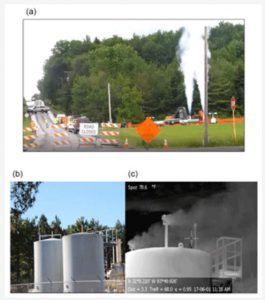
Figure 4(a) Gas blowdown for maintenance on a pipeline in Yates County, New York. While methane is invisible, the cooling caused by the blowdown condenses water vapor, leading to the obvious cloud. Photo courtesy of Jack Ossont. (b, c) Gas storage tanks receiving natural gas from feeder pipelines before compression for transport in high-pressure pipelines at the Haynseville shale formation, Texas. Photo on left was taken with a normal camera. Photo on the right was taken with a forward-looking infrared (FLIR) camera tuned to the infrared spectrum of methane, allowing visualization of methane, which is invisible in the normal camera view and to the naked eye. Photo courtesy of Sharon Wilson.
We conclude that increased methane emissions from fossil fuels likely exceed those from biogenic sources over the past decade (since 2007). The increase in emissions from shale gas (perhaps in combination with those from shale oil) makes up more than half of the total increased fossil-fuel emissions. That is, the commercialization of shale gas and oil in the 21st century has dramatically increased global methane emissions.
Note that while methane emissions are often referred to as “leaks”, some of the emissions include purposeful venting, including the release of gas during the flowback period immediately following hydraulic fracturing, the rapid release of gas from blowdowns during emergencies but also for routine maintenance on pipelines and compressor stations (Fig. 4a), and the steadier but more subtle release of gas from storage tanks (Fig. 4b) and compressor stations to safely maintain pressures (Howarth et al., 2011). This suggests large opportunities for reducing emissions, but at what cost? Do large capital investments for rebuilding natural gas infrastructure make economic sense, or would it be better to move towards phasing natural gas out as an energy source and instead invest in a 21st-century energy infrastructure that embraces renewable energy and much more efficient heat and transportation through electrification (Jacobson et al., 2013)?
In October 2018, the Intergovernmental Panel on Climate Change issued a special report, responding to the call of the United Nations COP21 negotiations to keep the planet well below 2 ∘C of the pre-industrial baseline (IPCC, 2018). They noted the need to reduce both carbon dioxide and methane emissions, and they recognized that the climate system responds more quickly to methane: reducing methane emissions offers one of the best routes for immediately slowing the rate of global warming (Shindell et al., 2012). Given our finding that natural gas (both shale gas and conventional gas) is responsible for much of the recent increases in methane emissions, we suggest that the best strategy is to move as quickly as possible away from natural gas, reducing both carbon dioxide and methane emissions. Natural gas is not a bridge fuel (Howarth, 2014).
Finally, in addition to contributing to climate change, methane emissions lead to increased ground-level ozone levels, with significant damage to public health and agriculture. Based on the social cost of methane emissions of USD 2700 to USD 6000 per ton (Shindell, 2015), our baseline estimate for increased emissions from shale gas of 9.4 Tg per year corresponds to damage to public health, agriculture, and the climate of USD 25 billion to USD 55 billion per year for each of the past several years. This is comparable to the wholesale value for this shale gas over these years.
New study: Fracking prompts global spike in atmospheric methane Press Release by Cornell University & the European Geosciences Union, 14 August 2019
As methane concentrations increase in the Earth’s atmosphere, chemical fingerprints point to a probable source: shale oil and gas, according to new Cornell University research published today in Biogeosciences, a journal of the European Geosciences Union.
The research suggests that this methane has less carbon-13 relative to carbon-12 (denoting the weight of the carbon atom at the centre of the methane molecule) than does methane from conventional natural gas and other fossil fuels such as coal.
This carbon-13 signature means that since the use of high-volume hydraulic fracturing – commonly called fracking – shale gas has increased in its share of global natural gas production and has released more methane into the atmosphere, according to the paper’s author, Robert Howarth, the David R. Atkinson Professor of Ecology and Environmental Biology at Cornell University in the US.
About two-thirds of all new gas production over the last decade has been shale gas produced in the United States and Canada, he said.
While atmospheric methane concentrations have been rising since 2008, the carbon composition of the methane has also changed. Methane from biological sources such as cows and wetlands have a low carbon-13 content – compared to methane from most fossil fuels. Previous studies erroneously concluded that biological sources are the cause of the rising methane, Howarth said.
Carbon dioxide and methane are critical greenhouse gases, but they behave quite differently in the atmosphere. Carbon dioxide emitted today will influence the climate for centuries to come, as the climate responds slowly to decreasing amounts of the gas.
Unlike its slow response to carbon dioxide, the atmosphere responds quickly to changes in methane emissions. “Reducing methane now can provide an instant way to slow global warming and meet the United Nations’ target of keeping the planet well below a 2-degree Celsius average rise,” Howarth said, referring to the 2015 Paris Agreement that boosts the global response to climate change threats.
Atmospheric methane levels had previously risen during the last two decades of the 20th century but leveled in the first decade of 21st century. Then, atmospheric methane levels increased dramatically from 2008–14, from about 570 teragrams (570 billion tons) annually to about 595 teragrams, due to global human-caused methane emissions in the last 11 years.
“This recent increase in methane is massive,” Howarth said. “It’s globally significant. It’s contributed to some of the increase in global warming we’ve seen and shale gas is a major player.”
“If we can stop pouring methane into the atmosphere, it will dissipate,” he said. “It goes away pretty quickly, compared to carbon dioxide. It’s the low-hanging fruit to slow global warming.”
The research published in Biogeosciences was funded by the Park Foundation and the Atkinson Center.
###
Please mention the name of the publication (Biogeosciences) if reporting on this story and, if reporting online, include a link to the paper (https://www.biogeosciences.net/16/3033/2019/) or to the journal website (https://www.biogeosciences.net/).
Contacts:
Robert W. Howarth
David R. Atkinson Professor of Ecology and Environmental Biology
Department of Ecology & Evolutionary Biology
Cornell University, Ithaca, US
+1 607-280-9981
email hidden; JavaScript is required
English
Jeff Tyson
Media Relations Office
Cornell University
+1 607-255-7701 or +1 607-793-5769
email hidden; JavaScript is required
@CornellMedia
Bárbara Ferreira
EGU Media and Communications Manager
Munich, Germany
+49-89-2050-76340
email hidden; JavaScript is required
@EuroGeosciences
More information
This press release is produced in collaboration with Cornell University. The research is presented in the paper ‘Ideas and perspectives: is shale gas a major driver of recent increase in global atmospheric methane?’ published in the EGU open access journal Biogeosciences on 14 August 2019.
The study was conducted by Robert W. Howarth (Department of Ecology & Evolutionary Biology, Cornell University, Ithaca, NY, US).
Refer also to:
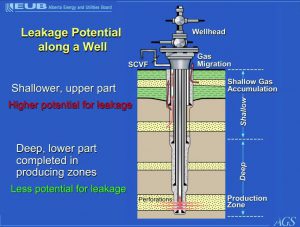
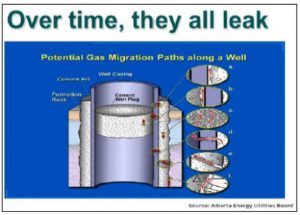
Trump Plans to End Methane Curbs That Oil Companies Want to Keep by Jennifer A. Dlouhy, Bloomberg, August 14, 2019
The Trump administration is readying a plan to end direct federal regulation of methane leaks from oil and gas facilities, even as some energy companies insist they don’t want the relief.
A draft proposal from the Environmental Protection Agency would prevent the federal government from directly targeting that potent greenhouse gas as it restricts emissions from oil wells and infrastructure, despite fears that time is running out to avert catastrophic consequences of climate change.
The White House is finishing its review of the EPA plan, which was described by people familiar with the matter who asked not to be named ahead of a formal announcement that is expected within weeks.
The proposal threatens to undermine the oil industry’s sales pitch that natural gas is a climate-friendly source of electricity — a cleaner-burning alternative to coal that can help power an energy-hungry world for decades to come. Dozens of oil companies have made voluntary pledges to keep methane in check, and some have warned the Trump administration that federal regulation specifically targeting it is essential for natural gas to maintain that reputation. …
More than 60 oil and gas companies have made voluntary commitments to pare emissions of methane, the chief ingredient of natural gas, though some of them insist federal regulation is still essential for the highly fragmented industry. For instance, BP Plc and Royal Dutch Shell Plc executives said in March that they favor federal regulation of the oil industry’s methane emissions, with BP asserting in an opinion piece that voluntary actions by a handful of companies “are not enough to solve the problem.”
****
Oil and gas companies piss ‘n spit on regulations and laws, imagine what they do to voluntary promises (hint, same as what they do with their self-imposed “guidelines”)

****
“Industry gets it,” said David Hayes, a former Interior Department official who leads the State Energy and Environmental Impact Center at New York University School of Law. “They recognize that this is a tremendous liability.” …
Walking Away
The EPA’s plan to walk away from specifically regulating methane dovetails with other Trump administration efforts to ease limits on emissions from power plants and automobiles. Critics cast the proposal as a part of a broad Trump administration retreat from the global fight against climate change.
The Senate’s top Democrat, Chuck Schumer, blasted the plan Wednesday, calling it “another disgraceful giveaway to corporate polluters at the expense of the public’s health, our environment and the fight to combat climate change.”
The Obama administration targeted the oil industry’s methane emissions in 2016, by requiring energy companies to frequently seek and plug leaks. Other U.S. requirements also acted to pare methane emissions but did so indirectly, by targeting other, conventional pollutants or seeking to stop the waste of natural gas extracted from federal lands.
Those targeted mandates on new wells triggered a legal requirement that EPA also regulate methane emissions from existing oilfield infrastructure — including more than a million wells on private land. However, plugging leaks on some decades-old, low-producing wells could be expensive and unruly — a burden that would fall disproportionately on smaller, independent oil companies.
“It changes the scope, from our industry, from a rule that’s dealing with 15,000 to 40,000 new sources a year to the million existing wells that are out there,” some 770,000 of which are low-producing sites, said Lee Fuller, executive vice president of the Independent Petroleum Association of America.
Imposing rigid requirements to frequently detect and repair leaks at those low-production wells, would be “a huge cost burden,” potentially eclipsing gross income from the sites, Fuller said. “It would shut in production at a lot of these wells.”
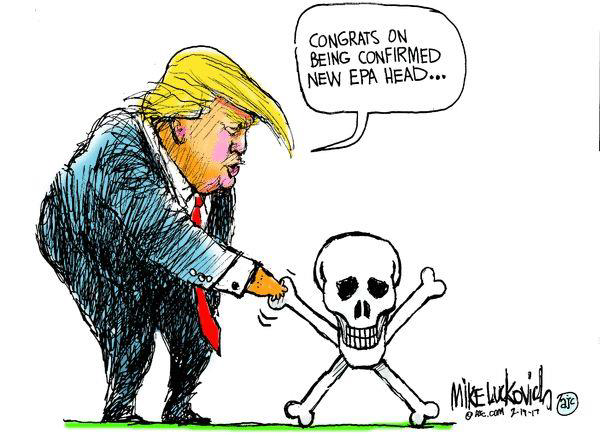
Fracking in U.S. and Canada linked to worldwide atmospheric methane spike by Kashmira Gander, August 14, 2019, News Week
Levels of methane—the second biggest contributor to climate change after carbon dioxide—have spiked in the atmosphere in the past decade. And a study says fracking in North America could be partly to blame.
The gas is linked to climate change, as well as ground-level ozone levels that can harm agriculture. It can also trigger a range of health problems, including chest pains, as well as reducing lung function and worsening conditions such as bronchitis, emphysema and asthma.
In the last half of the 20th, century levels of methane in the atmosphere rose. They then plateaued, and spiking in 2008. Robert W. Howarth of Cornell University, who published a study in the journal Biogeosciences, investigated fracking as a potential culprit.
Hydraulic fracturing, known as fracking, is the process of extracting gas and oil from shale sedimentary rock using pressurized liquid. The method is controversial and has been linked to contaminated drinking water in the U.S, methane gas escaping from wells into the atmosphere and earthquakes.
First performed in 1949, the fracking industry has boomed in the past decade or so. Between 2005 and 2015, global rates of fracking went from producing 31 billion cubic meters per year to 435 billion, according to Howarth. Of this, 89 percent occurred in the U.S., and 10 percent in Canada. The U.S Department of Energy forecasts production will spike to 1500 billion cubic meters per year by 2040.
For the new study, Howarth looked at existing research on the levels of certain carbon isotopes of atmospheric methane to find a potential source, and created an equation to investigate the link.
Methane is a compound made up of carbon and hydrogen. While methane released in the late 20th century was enriched with the carbon isotope 13C, Howarth highlights methane released in recent years features lower levels. That’s because the methane in shale gas has depleted levels of the isotope when compared with conventional natural gas or fossil fuels such as coal, he explained.
This lead Howarth to conclude: “The commercialization of shale gas and oil in the 21st century has dramatically increased global methane emissions.”
If trends of releasing methane continue, he said, this will “significantly increase global warming and undercut efforts” to meet the United Nations Framework Convention on Climate Change to keep post-industrial revolution global temperatures below 2 C.
Howarth urged those involved in the energy industries to “move as quickly as possible away from natural gas, reducing both carbon dioxide and methane emissions.”
The good news, argued Howarth, is that climate reacts quicker to methane than carbon dioxide, meaning cutting emissions of the gas emissions “could provide an opportunity to immediately slow the rate of global warming.”
This could help the commitment of the Paris Agreement be met.
Howarth said in a statement: “This recent increase in methane is massive. It’s globally significant. It’s contributed to some of the increase in global warming we’ve seen and shale gas is a major player.”
“If we can stop pouring methane into the atmosphere, it will dissipate. It goes away pretty quickly, compared to carbon dioxide. It’s the low-hanging fruit to slow global warming.”
Researchers not involved in the study welcomed Howarth’s efforts, but pointed out some limitations.
Grant Allen, professor of atmospheric physics at the U.K.’s University of Manchester, commented: “A wide range of different methane fluxes from different source types (e.g. fossil fuels, agriculture, wildfires and wetlands) can all simultaneously explain the observed trend in methane (and carbon isotopes of methane) within the limits of uncertainty in our knowledge of their carbon-isotopic fingerprints and estimates of total methane emitted from each source type.
“Other work has also proposed a role for changing chemical sinks of methane in the atmosphere. The jury is still out on the relative importance of all of these sources in explaining methane’s rise.”
Allen continued: “However, this paper makes a very important point—some sources of methane are within our gift to control, other (natural sources) are not as easily targeted. Controlling emissions from fracking, and fossil fuels in general, represents a potential policy quick fix to stemming the rise of methane still further.”
Quentin Fisher, professor of petroleum geoengineering at the U.K.’s University of Leeds, said he was “deeply skeptical” about the study.
“The results are extremely sensitive to highly questionable assumptions regarding the isotopic composition of methane found in shale. The arguments made by previous studies that increase in methane in the atmosphere is from biogenic sources, such as release from wetlands and agriculture or burning of biomass, seem far more convincing.”
“It’s also the case that the study itself admits that even if the increased methane concentrations were from shale that they are not a direct result of the hydraulic fracturing process,” he argued.
“For example, the USA has an aging gas transportation network, which results in significant methane leakages.”
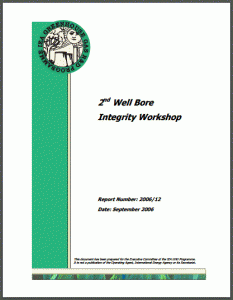
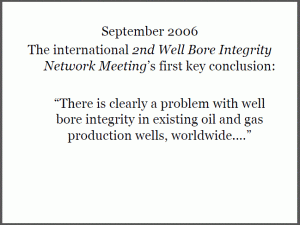
Then add industry’s ignorant and brute force frac’ing to the leaky mix, without addressing the worldwide well bore integrity problem.
This is how we deal with the problem in Alberta, comment by annie_fiftyseven to Andrew Nikiforuk’s article on Ernst’s lawyers, Murray Klippenstein and Cory Wanless, quitting: sums it up best:
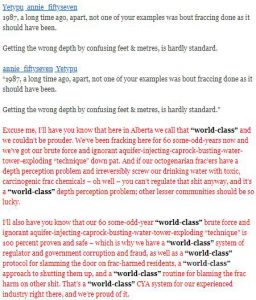
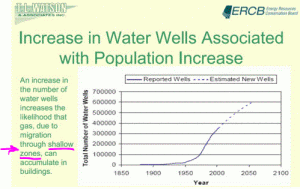
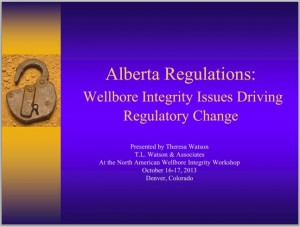

Alberta energy regulator gets a name change when it does something bad. It was ERCB, became EUB, then ERCB again, after Ernst lawsuit went public (detailing ERCB violating Ernst’s charter rights), government/CAPP changed it to AER
